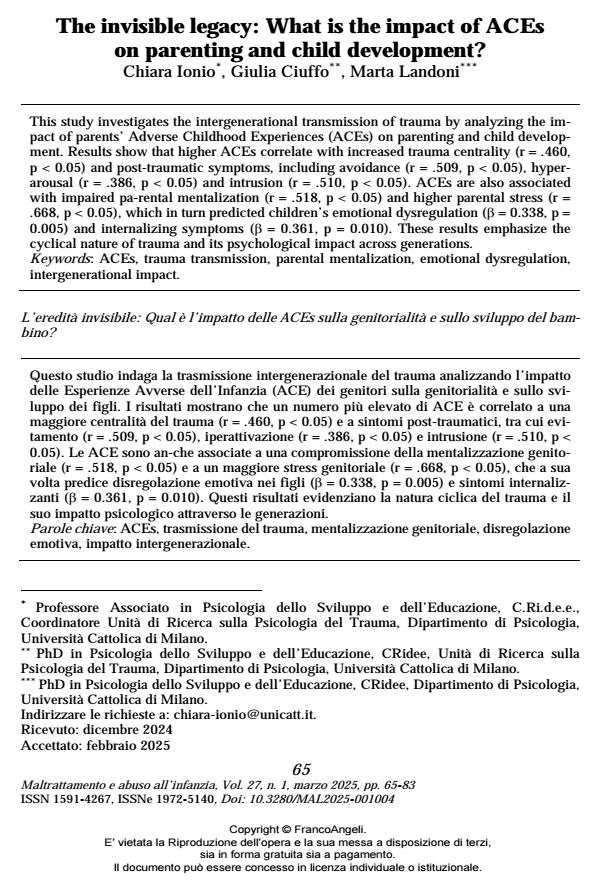The invisible legacy: What is the impact of ACEs on parenting and child development?
Titolo Rivista MALTRATTAMENTO E ABUSO ALL’INFANZIA
Autori/Curatori Chiara Ionio, Giulia Ciuffo, Marta Landoni
Anno di pubblicazione 2025 Fascicolo 2025/1
Lingua Inglese Numero pagine 19 P. 65-83 Dimensione file 99 KB
DOI 10.3280/MAL2025-001004
Il DOI è il codice a barre della proprietà intellettuale: per saperne di più
clicca qui
Qui sotto puoi vedere in anteprima la prima pagina di questo articolo.
Se questo articolo ti interessa, lo puoi acquistare (e scaricare in formato pdf) seguendo le facili indicazioni per acquistare il download credit. Acquista Download Credits per scaricare questo Articolo in formato PDF

FrancoAngeli è membro della Publishers International Linking Association, Inc (PILA)associazione indipendente e non profit per facilitare (attraverso i servizi tecnologici implementati da CrossRef.org) l’accesso degli studiosi ai contenuti digitali nelle pubblicazioni professionali e scientifiche
This study investigates the intergenerational transmission of trauma by analyzing the impact of parents’ Adverse Childhood Experiences (ACEs) on parenting and child development. Results show that higher ACEs correlate with increased trauma centrality (r = .460, p < 0.05) and post-traumatic symptoms, including avoidance (r = .509, p < 0.05), hyperarousal (r = .386, p < 0.05) and intrusion (r = .510, p < 0.05). ACEs are also associated with im-paired pa-rental mentalization (r = .518, p < 0.05) and higher parental stress (r = .668, p < 0.05), which in turn predicted children’s emotional dysregulation (ß = 0.338, p = 0.005) and internalizing symptoms (ß = 0.361, p = 0.010). These results emphasize the cyclical nature of trauma and its psychological impact across generations.
Questo studio indaga la trasmissione intergenerazionale del trauma analizzando l’impatto delle Esperienze Avverse dell’Infanzia (ACE) dei genitori sulla genitorialità e sullo sviluppo dei figli. I risultati mostrano che un numero più elevato di ACE è correlato a una maggiore centralità del trauma (r = .460, p < 0.05) e a sintomi post-traumatici, tra cui evitamento (r = .509, p < 0.05), iperattivazione (r = .386, p < 0.05) e intrusione (r = .510, p < 0.05). Le ACE sono an-che associate a una compromissione della mentalizzazione genitoriale (r = .518, p < 0.05) e a un maggiore stress genitoriale (r = .668, p < 0.05), che a sua volta predice disregolazione emotiva nei figli (β = 0.338, p = 0.005) e sintomi internalizzanti (β = 0.361, p = 0.010). Questi risultati evidenziano la natura ciclica del trauma e il suo impatto psicologico attraverso le generazioni.
Parole chiave:ACEs, trasmissione del trauma, mentalizzazione genitoriale, disregolazione emotiva, impatto intergenerazionale.
Chiara Ionio, Giulia Ciuffo, Marta Landoni, The invisible legacy: What is the impact of ACEs on parenting and child development? in "MALTRATTAMENTO E ABUSO ALL’INFANZIA" 1/2025, pp 65-83, DOI: 10.3280/MAL2025-001004